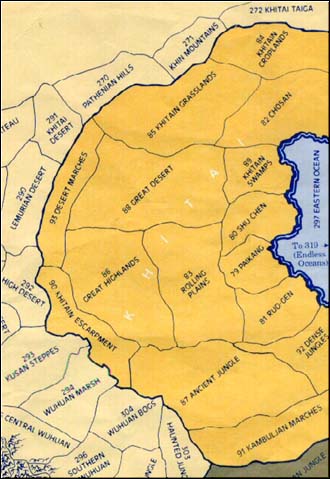
Khitai

"Then there were camels, and yellow-skinned men who wore silk robes and spoke in a weird tongue. (...) He was a magician from far Khitai, returning to his native kingdom after a journey to Stygia. He took me with him to purple-towered Paikang, its minarets rising amid the vine-festooned jungles of bamboo, and there I grew to womanhood under his teaching. Age had steeped him deep in black wisdom, not weakened his powers of evil. Many things he taught me --" -- Robert E. Howard: "A Witch Shall Be Born"


An important kingdom of the Far East, shielded from western invasion by a Great Wall. Its people were called Khitans. It was comprised of many city-states in the north, the greatest of which was Paikang.
For centuries, the fragmented city-states of Khitai bickered like crows picking at a corpse, each maintaining the fiction that it (and it alone) represented the fallen Khari empire. Periodically, a powerful ruler rose and united some of the city-states, and the long-imagined Middle Kingdom of Khitai was (temporarily) established. But the huge distances involved in governing such a kingdom, combined with the demand for independence which burst forth at the time of the original slave-revolt, always brought these empires to collapse.
Khitai extended its hegemony over a vast area of the Far East -- from the northern taiga forests to the edge of the Kambujan jungle. Its influence weakened beyond the western satellite kingdom of Kusan, but it claimed all the land east of the Mountains of Night.

Khitai had a varied economy. The city-states were centers of manufacturing and commerce. The craftsmen doubtless produced sophisticated art-objects. There was ample food from myriad small farms and ranches. Mines produced gold, silver, other metals, and precious stones. Silken textiles, rare drugs, spices, and magical paraphernalia were traded to the West.
The terrain of northern Khitai is depicted in Return of Conan as being "jungle", but this can hardly be the case. Even if the climate was warmer and wetter, the word "jungle" must be reinterpreted to mean "dense humid-continental forest", similar to that of Pictland.
The people of Khitai were very ancient -- undoubtedly flourishing during pre-Cataclysmic times. After the Cataclysm, refugee Lemurians entered Khitai and were promptly enslaved. Later, the Lemurians rebelled and overthrew the ancient Khitan civilization before migrating westward.
Khitai is nearly legendary to the average Hyborian, although the more easterly peoples (such as the Turanians and Vendhyans) maintain considerable commerce with the kingdoms of Khitai. Regular caravans now cross the Hyrkanian steppe to reach the kingdom of Kusan and the central city-states. Some traders have even approached Kambuja, hoping to curry the favor of Pra-Eun with their western trinkets. Some Westerners urge caution, however, worried that too much contact with Khitai may bring them to move westward, like their Hyrkanian predecessors.
References: Witch Shall Be Born, Flame Knife, Treasure of Tranicos, Hour of the Dragon, Tower of the Elephant, Curse of the Monolith, Return of Conan, et al.
- Population: 24,600,000
- Capital: Paikang (pop. 3,200,000)
- Ruler: Yah-Chieng, Master of the Scarlet Circle
- Major cities: Shu-Chen (pop. 1,370,000), Rou-Gen (pop. 670,000)
- Resources: Foodstuffs, domesticated animals, gold, silver, precious stones, silk, spices, drugs, lotus blossom, charms and amulets, exotic items (peacock feather fans, carved jade, porcelain)
- Imports:
- Allies: Kusan (satellite)
- Enemies: Kambuja, Hyrkania
- Tech level: Oriental
- Religion: Yun
